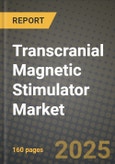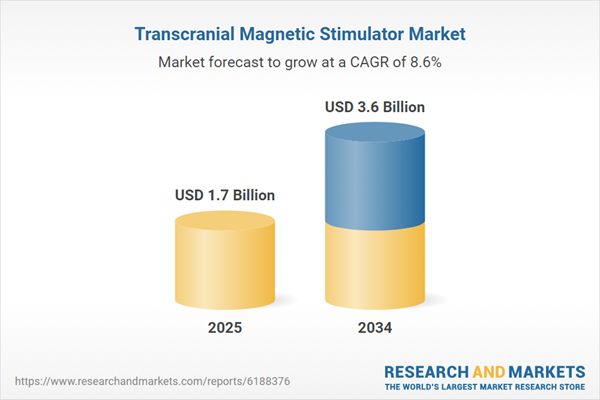The transcranial magnetic stimulator (TMS) market is gaining significant momentum due to its growing adoption as a non-invasive, FDA-approved therapy for neurological and psychiatric conditions. Initially developed for treatment-resistant depression, TMS has expanded its clinical relevance to include anxiety, PTSD, Parkinson’s disease, chronic pain, and even stroke rehabilitation. The technology works by delivering magnetic pulses to specific brain regions, modulating neural activity without requiring anesthesia or systemic drugs. As awareness of mental health increases globally and stigma surrounding therapy decreases, patients and practitioners alike are seeking safer, drug-free alternatives to conventional pharmacological treatments. Moreover, continuous improvements in coil design, stimulation protocols, and targeting accuracy have made TMS more effective and accessible. Hospitals, outpatient centers, and private clinics are rapidly integrating TMS into their service offerings, supported by improving insurance coverage and government backing for mental health initiatives, especially in North America and Europe.
The transcranial magnetic stimulator market witnessed robust growth fueled by new indications and regulatory approvals. Several clinical studies demonstrated the effectiveness of deep TMS in treating obsessive-compulsive disorder (OCD), postpartum depression, and smoking addiction, leading to expanded insurance reimbursement and wider patient acceptance. Technological enhancements included more compact and portable TMS devices, making home-use applications a near-future reality. Startups and medtech giants alike introduced AI-powered TMS systems capable of personalizing treatment protocols based on patient-specific brainwave data. This helped improve response rates and reduce session variability. In parallel, global mental health awareness campaigns increased demand for non-invasive therapies, prompting new TMS centers to emerge in urban and secondary healthcare markets. The Asia-Pacific region, especially Japan and South Korea, began showing strong interest in TMS for cognitive enhancement and elderly mental wellness, further diversifying the market’s applications and boosting investment into regional clinical infrastructure.
The transcranial magnetic stimulator market is poised to move into a more mainstream therapeutic role across neurological care. With increasing clinical evidence supporting its neuroplasticity benefits, TMS is expected to become part of multimodal treatment strategies alongside cognitive behavioral therapy, pharmacotherapy, and neurofeedback. Integration with wearable EEG systems and brain-computer interface platforms will allow for real-time feedback loops and adaptive stimulation protocols tailored to individual neural responses. Moreover, research into TMS applications for Alzheimer’s disease, autism spectrum disorder, and migraine prevention is progressing, with promising early results pointing to potential expansion in therapeutic indications. As regulatory agencies develop clearer frameworks for personalized neuromodulation therapies, and reimbursement becomes more comprehensive in developing economies, market growth is likely to accelerate. Meanwhile, increased affordability and miniaturization of devices will push the TMS market beyond clinical settings into wellness and preventive care, positioning it as a transformative solution in brain health and mental well-being.
Key Insights: Transcranial Magnetic Stimulator Market
- Personalized TMS protocols powered by artificial intelligence are revolutionizing treatment outcomes by tailoring session frequency, pulse intensity, and target regions based on real-time brainwave monitoring. This approach significantly improves response rates and enables clinicians to optimize therapeutic regimens for individual patients.
- Portable and home-use TMS devices are emerging as a major trend, allowing patients to receive regular treatment outside clinical settings. These devices are designed with simplified interfaces and remote monitoring capabilities, offering greater flexibility and convenience, particularly for patients with mobility or geographic access challenges.
- Deep TMS, which penetrates deeper brain regions than traditional coils, is gaining clinical adoption for conditions like OCD, bipolar depression, and addiction. This technique is expanding TMS use beyond major depressive disorder and improving therapeutic reach for more treatment-resistant psychiatric conditions.
- Integration with neuroimaging and brain mapping tools is enhancing treatment precision. Technologies such as fMRI and EEG help clinicians identify hyperactive or underactive brain regions, ensuring magnetic pulses are delivered to the most therapeutically effective areas for each patient’s unique condition.
- Growing interest in wellness and cognitive performance optimization is creating demand for TMS applications beyond medical treatment. Clinics are beginning to offer TMS as a tool for enhancing focus, memory, and emotional regulation, especially among executives, athletes, and students seeking non-pharmacologic brain enhancement.
- Rising prevalence of mental health disorders and neurological conditions is driving demand for alternative, non-invasive treatments. With millions suffering from depression, anxiety, and PTSD globally, TMS offers a promising option for patients unresponsive to medications or those seeking drug-free therapies.
- Increased awareness and destigmatization of mental health treatment are encouraging more people to seek care. Government campaigns, public discourse, and social media advocacy have made neuromodulation therapies like TMS more widely accepted and desirable among diverse demographics and age groups.
- Favorable reimbursement policies and regulatory approvals for expanded indications are enhancing market accessibility. Countries across Europe and North America have extended coverage for TMS procedures, making them financially viable for both healthcare providers and patients.
- Technological advancements in coil design, magnetic pulse control, and AI integration are improving device efficacy and user experience. These innovations are leading to shorter treatment durations, higher patient comfort, and better clinical outcomes, encouraging broader adoption in healthcare practices.
- The high initial cost of TMS devices and limited availability of trained professionals pose barriers to widespread adoption, particularly in developing regions. Many clinics are unable to afford the equipment, and the lack of certified operators restricts procedural scalability and patient access in resource-constrained healthcare environments.
Transcranial Magnetic Stimulator Market Segmentation
By Type
- Deep Transcranial Magnetic Stimulator (dTMS)
- Repetitive TMS (rTMS)
- Other Types
By Age
- Children
- Adults
By Application
- Parkinson’s Disease
- Depression
- Alzheimer’s Disease
- Epilepsy
- Other Applications
Key Companies Analysed
- BrainsWay Ltd.
- Magstim Company Ltd.
- MagVenture A/S
- Neuronetics, Inc. (NeuroStar)
- Nexstim Plc
- Yiruide Medical
- CloudTMS
- Neurosoft
- eNeura Inc.
- Localite GmbH
Transcranial Magnetic Stimulator Market Analytics
The report employs rigorous tools, including Porter’s Five Forces, value chain mapping, and scenario-based modeling, to assess supply-demand dynamics. Cross-sector influences from parent, derived, and substitute markets are evaluated to identify risks and opportunities. Trade and pricing analytics provide an up-to-date view of international flows, including leading exporters, importers, and regional price trends.Macroeconomic indicators, policy frameworks such as carbon pricing and energy security strategies, and evolving consumer behavior are considered in forecasting scenarios. Recent deal flows, partnerships, and technology innovations are incorporated to assess their impact on future market performance.
Transcranial Magnetic Stimulator Market Competitive Intelligence
The competitive landscape is mapped through proprietary frameworks, profiling leading companies with details on business models, product portfolios, financial performance, and strategic initiatives. Key developments such as mergers & acquisitions, technology collaborations, investment inflows, and regional expansions are analyzed for their competitive impact. The report also identifies emerging players and innovative startups contributing to market disruption.Regional insights highlight the most promising investment destinations, regulatory landscapes, and evolving partnerships across energy and industrial corridors.
Countries Covered
- North America - Transcranial Magnetic Stimulator market data and outlook to 2034
- United States
- Canada
- Mexico
- Europe - Transcranial Magnetic Stimulator market data and outlook to 2034
- Germany
- United Kingdom
- France
- Italy
- Spain
- BeNeLux
- Russia
- Sweden
- Asia-Pacific - Transcranial Magnetic Stimulator market data and outlook to 2034
- China
- Japan
- India
- South Korea
- Australia
- Indonesia
- Malaysia
- Vietnam
- Middle East and Africa - Transcranial Magnetic Stimulator market data and outlook to 2034
- Saudi Arabia
- South Africa
- Iran
- UAE
- Egypt
- South and Central America - Transcranial Magnetic Stimulator market data and outlook to 2034
- Brazil
- Argentina
- Chile
- Peru
Research Methodology
This study combines primary inputs from industry experts across the Transcranial Magnetic Stimulator value chain with secondary data from associations, government publications, trade databases, and company disclosures. Proprietary modeling techniques, including data triangulation, statistical correlation, and scenario planning, are applied to deliver reliable market sizing and forecasting.Key Questions Addressed
- What is the current and forecast market size of the Transcranial Magnetic Stimulator industry at global, regional, and country levels?
- Which types, applications, and technologies present the highest growth potential?
- How are supply chains adapting to geopolitical and economic shocks?
- What role do policy frameworks, trade flows, and sustainability targets play in shaping demand?
- Who are the leading players, and how are their strategies evolving in the face of global uncertainty?
- Which regional “hotspots” and customer segments will outpace the market, and what go-to-market and partnership models best support entry and expansion?
- Where are the most investable opportunities - across technology roadmaps, sustainability-linked innovation, and M&A - and what is the best segment to invest over the next 3-5 years?
Your Key Takeaways from the Transcranial Magnetic Stimulator Market Report
- Global Transcranial Magnetic Stimulator market size and growth projections (CAGR), 2024-2034
- Impact of Russia-Ukraine, Israel-Palestine, and Hamas conflicts on Transcranial Magnetic Stimulator trade, costs, and supply chains
- Transcranial Magnetic Stimulator market size, share, and outlook across 5 regions and 27 countries, 2023-2034
- Transcranial Magnetic Stimulator market size, CAGR, and market share of key products, applications, and end-user verticals, 2023-2034
- Short- and long-term Transcranial Magnetic Stimulator market trends, drivers, restraints, and opportunities
- Porter’s Five Forces analysis, technological developments, and Transcranial Magnetic Stimulator supply chain analysis
- Transcranial Magnetic Stimulator trade analysis, Transcranial Magnetic Stimulator market price analysis, and Transcranial Magnetic Stimulator supply/demand dynamics
- Profiles of 5 leading companies - overview, key strategies, financials, and products
- Latest Transcranial Magnetic Stimulator market news and developments
Additional Support
With the purchase of this report, you will receive:- An updated PDF report and an MS Excel data workbook containing all market tables and figures for easy analysis.
- 7-day post-sale analyst support for clarifications and in-scope supplementary data, ensuring the deliverable aligns precisely with your requirements.
- Complimentary report update to incorporate the latest available data and the impact of recent market developments.
This product will be delivered within 1-3 business days.
Table of Contents
Companies Mentioned
- BrainsWay Ltd.
- Magstim Company Ltd.
- MagVenture A/S
- Neuronetics
- Inc. (NeuroStar)
- Nexstim PLC
- Yiruide Medical
- CloudTMS
- Neurosoft
- eNeura Inc.
- Localite GmbH
Table Information
| Report Attribute | Details |
|---|---|
| No. of Pages | 160 |
| Published | October 2025 |
| Forecast Period | 2025 - 2034 |
| Estimated Market Value ( USD | $ 1.7 Billion |
| Forecasted Market Value ( USD | $ 3.6 Billion |
| Compound Annual Growth Rate | 8.6% |
| Regions Covered | Global |
| No. of Companies Mentioned | 11 |









